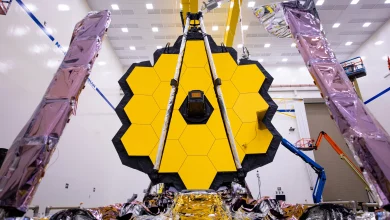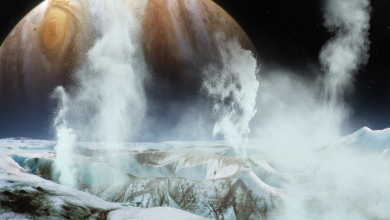Latest Articles
-
Dec- 2021 -1 DecemberClimate Change

Sentinel-6 Mission Returning Most Precise Data Ever on Sea Level
Lead Image: The Copernicus Sentinel-2 mission takes us over the Tarawa Atoll in the Republic of Kiribati – a remote Pacific nation threatened by rising seas. The Republic of Kiribati is an independent island nation consisting of some 33 atolls near the equator in the central Pacific. The islands are spread over approximately 3.5 million sq km of ocean, but with a total land area of only 800 sq km. Tarawa Atoll, pictured here, lies approximately halfway between Hawaii and Australia. Tarawa consists of a large lagoon fringed by a V-shaped reef, around 35 km long, and is made up…
Read More » -
1 DecemberNASA

Seeing the universe in the Mid-Infrared with James Webb’s MIRI instrument
Lead image: James Webb Space Telescope with its iconic gold mirror fully deployed for testing. Credit: Northrop Grumman The James Webb Space Telescope (JWST), presently tracking toward a launch no earlier than December 22 on an Ariane 5 rocket from the Guiana Space Centre in South America, will revolutionize in-space astronomy, particularly with its Mid-InfraRed Instrument, or MIRI. The instrument itself requires special cooling to drop its temperature to just 6 Kelvin — a cooling system that cannot be fully tested on Earth before launch. To discuss this and other elements of the MIRI component of JWST, NASASpaceflight spoke with…
Read More » -
1 DecemberNASA

Are Water Plumes Spraying From Jupiter’s Moon Europa? NASA’s Europa Clipper Spacecraft Is on the Case
Lead Image: On the left is a view of Europa taken on March 2, 1979, by the Voyager 1 spacecraft. Next is a color image of Europa taken by the Voyager 2 spacecraft during its close encounter on July 9, 1979. On the right is a view of Europa made from images taken by the Galileo spacecraft in the late 1990s. Credit: NASA/JPL Finding plumes at Europa is an exciting prospect, but scientists warn it’ll be tricky, even from up close. In 2005, images of a brilliant watery plume erupting from the surface of Saturn’s moon Enceladus captivated the world.…
Read More » -
Nov- 2021 -30 NovemberScience-Tech

Xenobots: Scientists Build the First-Ever Living Robots That Can Reproduce
An AI-designed “parent” organism (C shape; red) beside stem cells that have been compressed into a ball (“offspring”; green). Credit: Douglas Blackiston and Sam Kriegman AI-designed Xenobots reveal entirely new form of biological self-replication—promising for regenerative medicine. To persist, life must reproduce. Over billions of years, organisms have evolved many ways of replicating, from budding plants to sexual animals to invading viruses. Now scientists have discovered an entirely new form of biological reproduction — and applied their discovery to create the first-ever, self-replicating living robots. The same team that built the first living robots (“Xenobots,” assembled from frog cells —…
Read More » -
30 NovemberSpace

Supermassive Black Holes on a Collision Course: Closest Pair of Supermassive Black Holes to Earth Ever Discovered
Lead Image: An artist’s impression of a close pair of black holes. Using the European Southern Observatory’s Very Large Telescope (ESO’s VLT), astronomers have revealed the closest pair of supermassive black holes to Earth ever observed. The two objects also have a much smaller separation than any other previously spotted pair of supermassive black holes and will eventually merge into one giant black hole. Located in the galaxy NGC 7727 in the constellation Aquarius, the supermassive black hole pair is about 89 million light-years away from Earth. Although this may seem distant, it beats the previous record of 470 million…
Read More »










